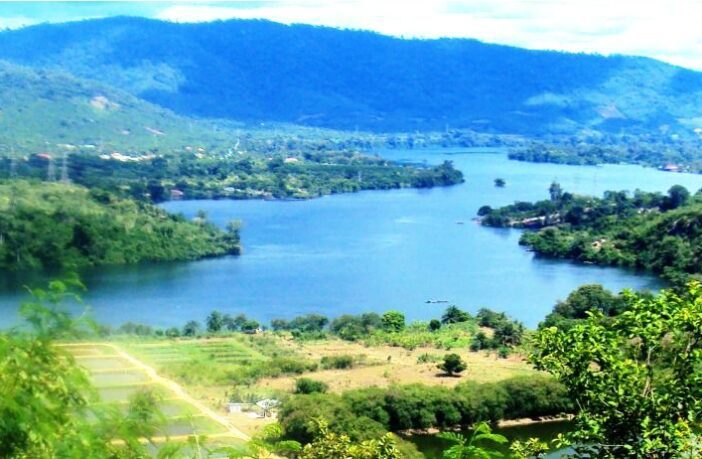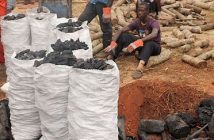Lake Volta, the largest artificial reservoir in the world based on surface area, is contained behind the Akosombo Dam which generates a substantial amount of Ghana’s electricity.
Located in Ghana, it has a surface area of 8,502 square kilometres (3,283 sq mi; 2,101,000 acres), and extends from Akosombo in the south to the northern part of the country.
The White Volta River and the Black Volta River, which used to merge where the reservoir’s centre is now, to form the one Volta River, are now separated by the Akosombo Dam. The Volta River now flows from the dam’s powerhouse exits to the Atlantic Ocean in southern Ghana.
The main islands within the lake are Dodi, Dwarf, and Kporve. Digya National Park lies on part of the lake’s western shore.
The lake is said to have been formed by the Akosombo Dam, which was originally conceived by the geologist Albert Ernest Kitson in 1915, but whose construction only began in 1961 with completion in 1965. Because of the formation of Lake Volta, about 78,000 people were relocated[5] to new towns and villages, along with 200,000 animals belonging to them. About 120 buildings were destroyed, not including small residences, and over 3,000 square miles (7,800 km2) of territory were flooded.
In the beginning of 2007, concerns were expressed over the electricity supply from the dam due to low water levels in the Lake Volta reservoir. Some sources said this was due to problems with drought that are a consequence of global warming.
During the latter half of 2007, much of this concern was abated when heavy rain fell in the catchment area of Volta River. In 2010, the highest-ever water level was recorded at the dam. This necessitated the opening of the flood gates at a reservoir elevation of 84.45 m (277 ft), and for several weeks, water was spilled from the lake, causing some flooding downstream
BENEFITS OF LAKE VOLTA
Because the lake is contained just behind the dam, it’s unlikely to talk about Lake Volta without mentioning the Akosombo Dam. The Akosombo Dam generates 912 MW of energy for the country, as well as for export to Togo, Benin, and other adjacent countries in exchange for foreign currency.
Lake Volta is also crucial for transportation, as it serves as a channel for ferries and commercial vessels. Because the massive lake is located in a tropical climate, the water is naturally warm all year. Lake Volta can support a big population of fish and large fisheries with proper management.
The lake also attracts tourism, and tourist cruises visit the island of Dodi.
Recent developments include a large-scale enterprise to harvest submerged timber from the flooded forests under Lake Volta. This project harvests high-value tropical hardwood without requiring additional logging or destruction of existing forest and, according to Wayne Dunn, “could generate the largest source of environmentally sustainable natural tropical hardwood in the world.”
The Ghanaian-owned company Underwater Forest Resources has been said to have committed itself to making said lumber available in the global market, while Flooring Solutions Ghana have become the suppliers of hardwood floors, using the rare wood from the Lake.
In addition to generating foreign currency for the region and reducing the dependence of locals on fishing as a primary economic activity, the removal of submerged trees is improving navigation on the lake and increasing safety.
NEGATIVE SIDE OF THE LAKE
An estimated 7,000 to 10,000 children work in the fishing industry on Lake Volta. The nature of their employment has been described as slavery in The Guardian and by the CNN Freedom Project.
This has been described as sensationalism by Betty Mensah and the academic Samuel Okyere since many of the children and youth whose wages are given upfront to their parents grow up to become self-sufficient fishermen in adulthood who in turn hire children themselves and could therefore also be characterized as apprentices. They conclude, that many children may suffer under exploitative work but are not enslaved.
SOURCES:
https://en.m.wikipedia.org/wiki/Akosombo_Dam
https://www.britannica.com/place/Lake-Volta
https://web.archive.org/web/20120304011055/http://www.gsb.stanford.edu/news/bmag/sbsm0711/feature-harvest.html
https://www.aljazeera.com/indepth/opinion/cnn-reported-child-slaves-enslaved-190315103733047.html





